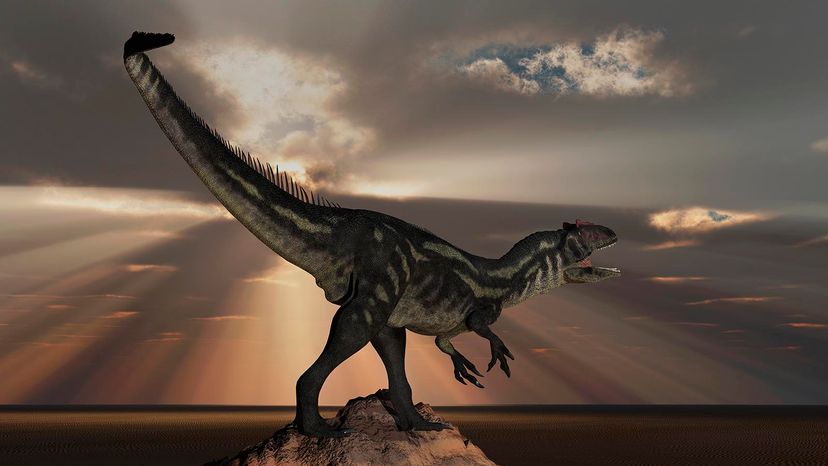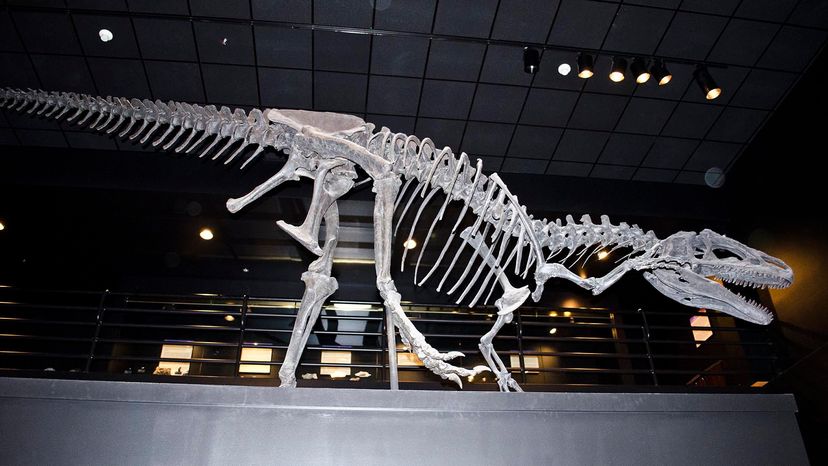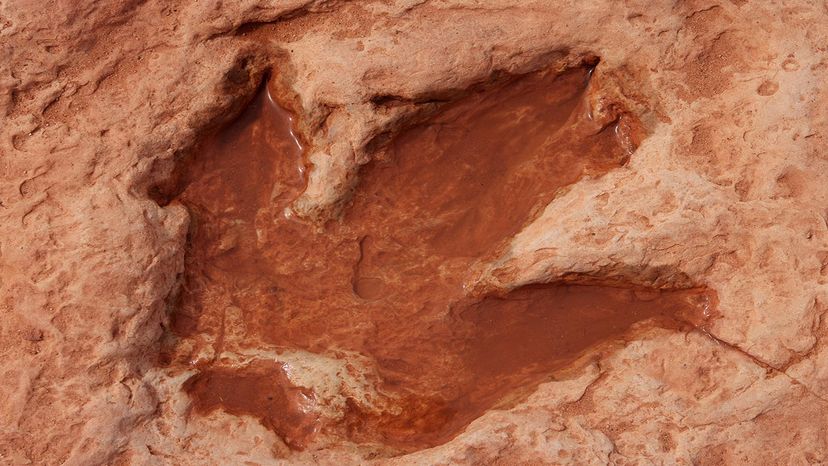
Between about 157 and 145 million years ago,Allosaurus— a large predatorydinosaur— stalked North America and Europe.
Advertisement

Between about 157 and 145 million years ago,Allosaurus— a large predatorydinosaur— stalked North America and Europe.
Advertisement
Thefossilrecord suggests the beast was rather common. And did we mention it was big? A full grownAllosauruscould grow to be 34 feet (10.4 meters) long, 9 feet (2.8 meters) tall at the hip and around 3.2 tons (2.9 metric tons) in weight.
Yet even giant carnivores take their lumps from time to time. Ladies and gents, meet "Big Al."
Advertisement
A subadultAllosauruswith a killer nickname, "Big Al" lived in what's now north-central Wyoming. Scientists would eventually recover 95 percent of this flesh-eating dinosaur's skeleton.
Look closely at his (or maybe her?) remains and you'll find no fewer than19 separate bone fractures. Somehow, Al sustained injuries to multiple backbones, toe bones and ribs. There's also evidence of aserious infectionon the right foot.
Advertisement
If you liked the original, you'lllovethe sequel. "Big Al" was unearthed at a Wyoming quarry in 1991. Five years later, fossil hunters working in the same state found anotherAllosaurus骨架被称为“Big Al 2."
Just like its predecessor, this specimen was pretty banged up. Many of its bones had been fractured or otherwise damaged — only to be re-healed during the dinosaur's lifetime. (Although one hip injury apparently never healed over and may have been implicated in the demise of Big Al 2.)
OtherAllosaurusfossils also bear the tell-tale signs of serious wounds. To fully appreciate these, we need to take a step back and consider the animal's role in its environment.

Advertisement
Allosauruslived during the Late Jurassic Period. Back then, giant herbivorous dinosaurs called "sauropods" thundered across the planet. We often find their bones in close association withAllosaurusmaterial.
AtDinosaur National Monument, which straddles the Utah-Colorado border, there's a protected quarry where visitors can look at a jumbled collection of fossils that've been lying together for the past 149 million years.
Advertisement
BesidesAllosaurusremains, this quarry includes the bones of suchlong-necked sauropodsas浸lodocus,CamarasaurusandApatosaurus.Fossils belonging to the unrelated spiky-tailed plant-eaterStegosaurusare also present.
These were just some of the vegetarian dinosAllosaurusinteracted with. And there was competition at the buffet line. Two of its rival predators in Late Jurassic North America were the 39-foot (11.9-meter)- longTorvosaurusandCeratosaurus, a horn-nosed carnivore that could grow over 19 feet (6 meters) long. The latter had ashort cameoin "Jurassic Park III" (2001).
Advertisement
Compared to some other dinosaurs,Allosaurushad aweak bite force. The bite ofTyrannosaurus rex— a famous carnivore that evolved tens of millions of years after the lastAllosaurusdied out — may have beenfour times stronger.
Advertisement
Even so,Allosaurusperformed well under pressure; mathematical models show the beast's head could withstand lots ofphysical strain.
In 2013, paleontologist Eric Snively and his colleagues usedcomputer simulationsto learn more about how this dinosaur dismembered its prey. According to their research,Allosaurusmay have sometimes behaved like an overgrown falcon at dinner.
Advertisement
The animal's skull was light and its neck muscles were peculiar. With their simulations, Snively and company showedAllosauruswould've had an easy time plucking meat off corpses by grabbing a hunk of flesh in its jaws and then yanking its head backwards.Falconsdo the same thing today.
But while those hunting birds have flight-ready wings,Allosaurushad clawed hands. Noting their size and range of motion, dino expert Kenneth Carpenterwrote in 2002thatAllosauruscould use its arms to "grasp moderately large prey and pull it towards the body."
Advertisement
What counted as "moderately large prey" for a ravenousAllosaurus? Maybe beaked herbivores like the 23-foot (7-meter)Camptosaurusfit the bill, or perhaps juvenile sauropods.
IfAllosaurushuntedadultsauropods, scientists aren't sure how. Some species alive in the Late Jurassic were around24 to 34 times heavierthan even the biggestAllosaurus, so the predators might not have bothered. A few experts thinkAllosaurusonly targeted young, sick or dead sauropods, leaving healthy grownupsalone.
Advertisement
On the other hand, it's possible the dinosaur used its serrated teeth to rip the flesh off of giant, still-living sauropods in nonfatal attacks. There's a pretty awesome name for this hypothetical feeding technique: "flesh grazing." Wicked.
Bite markstell usStegosauruswas on the menu. Only sometimes, attacking an armored dinosaur might not have been the brightest idea. OneAllosauruspubic bone shows a gaping wound which matches the size and shape of aStegosaurustail spike. That's a roundabout way of saying the carnivore was likelystabbed in the crotch.

Advertisement
Here's another grim development:Allosaurushas beensuspected of cannibalism.
Stephanie Drumheller, an earth scientist at the University of Tennessee, led asurvey, published in the May 2020 issue of the journal Plos One, of 2,368 fossil bones all recovered at the same Jurassic quarry in Colorado. Almost 29 percent bore the bitemarks of meat-eating dinosaurs with serrated teeth.
Advertisement
Many of these gnawed-on bones belonged to sauropods and other herbivores. However, some of them came fromAllosaurus.
SinceAllosaurusis also the most abundant predatory dinosaur found at this dig site, it's entirely possible that we're looking at evidence of cannibalistic behavior.
Advertisement
No discussion aboutAllosauruswould be complete without mentioning Utah's mysteriousCleveland-Lloyd Dinosaur Quarry(CLDQ).
Fossils of 10 different dino species have been excavated here, including plant-eaters likeStegosaurusandApatosaurus. Yet a remarkable 66 percent of all the dinosaur bones found in the CLDQ were left behind byAllosaurus.
Advertisement
Altogether, the quarry has yielded parts ofat least 46Allosaurusskeletons. Some were juveniles, others were full-grown adults. But they all died in the same spot.
The question is, why? Why are the numbers so skewed? Why isAllosaurusso overrepresented at the CLDQ? Several explanations have been put forth over the years.
Maybe the CLDQ was once a Jurassicpredator trap.
Basically, that's a place where herbivores get caught in thick mud (or another substance) and then attract carnivores who die the same way. All those bodies attracteven morecarnivores, with dead and dying predators vastly outnumbering prey species.
Critics say therarity of bite markson the quarry's dinosaur bones is a strike against this hypothesis, though.
It's also possible the CLDQ was the home of a poisoned watering hole — or a normal one that dried up, leaving thirsty dinosaurs to die on its banks. Another proposed scenarioblames floodingfor the accumulation of skeletons.
Advertisement
Originally Published: Mar 20, 2008
Please copy/paste the following text to properly cite this HowStuffWorks.com article:



Advertisement